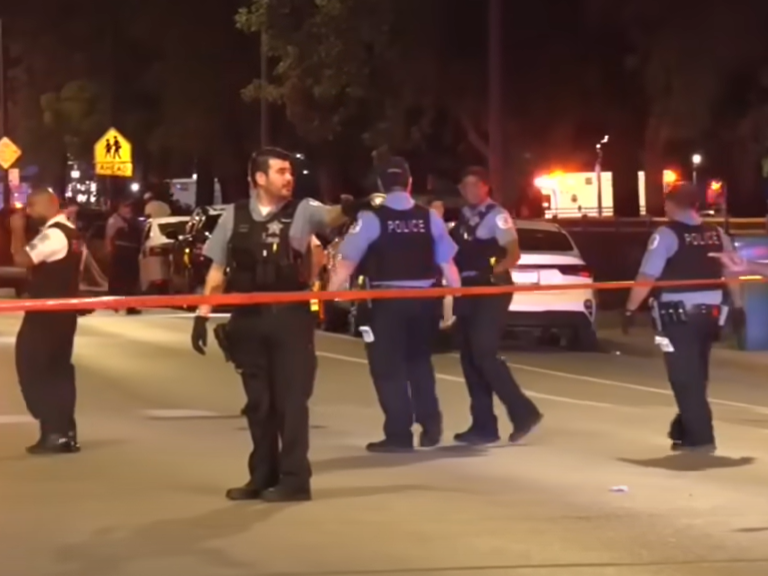Labor Day Weekend Violence in Chicago: At Least 53 Shot, 7 Fatally
The city of Chicago witnessed a tragic Labor Day weekend, with at least 53 people shot, seven of whom succumbed to their injuries. This wave of violence included multiple mass shootings across various neighborhoods, sparking ongoing concerns about public safety and the state of violence in the city.
The shootings, which took place primarily in Chicago’s Humboldt Park and Bronzeville neighborhoods, have prompted heightened attention from local officials and national figures alike. The news comes amidst President Donald Trump’s ongoing threats to deploy the National Guard in Chicago to combat the rising violence, an idea that has met with mixed reactions from residents and local leaders.

The Weekend’s Deadly Shootings
The violence began early in the weekend, with authorities reporting multiple shootings in different parts of the city. In total, 52 individuals were injured across a span of a few days, marking a harrowing period for residents and authorities alike. Of the 52 injured, seven individuals tragically died, underscoring the deadly nature of the violence.
Among the most notable incidents were three mass shootings. The first occurred in the Humboldt Park neighborhood at the intersection of Hatton and California, while the second and third took place in the Bronzeville neighborhood at 35th and State and 63rd and Cottage Grove, respectively. The shootings occurred in quick succession, which has led to heightened fear and outrage among local residents who have expressed their concerns about the safety of their neighborhoods.
The most recent mass shooting took place near 36th and Cottage Grove, in the Bronzeville area. Five people were injured, including a 17-year-old who remains in critical condition. The incident occurred just hours after a mass shooting in the same neighborhood, raising concerns about the growing frequency and intensity of such attacks. This was the second mass shooting in Bronzeville within 48 hours. The previous one had occurred on Saturday night near 35th and State, during a drive-by shooting that left seven people injured.
Local Response to the Violence
As the violence unfolded, local leaders and residents voiced their concerns and called for action. Many expressed frustration over the ongoing gun violence, urging both law enforcement and the community to step up their efforts to prevent further bloodshed.
In response to the recent surge in shootings, Alderman Pat Hall of the Bronzeville neighborhood has advocated for additional police manpower to address the large illegal gatherings and pop-up parties that have become a common occurrence in the area. These gatherings are often seen as contributing factors to the violence, and Hall believes that increased law enforcement presence could help deter such activities.
Simultaneously, Mayor Brandon Johnson took action by signing an executive order aimed at preventing the Trump administration from sending the National Guard into the streets of Chicago. The move was intended to maintain local control over the situation and to prevent federal intervention, which many in the community believe would further exacerbate tensions between law enforcement and residents. Mayor Johnson’s position aligns with the sentiment of many local leaders who are keen to resolve the crisis without external interference.
However, the idea of National Guard intervention remains divisive. While some residents argue that the presence of troops could help reduce the violence and restore order, others, including community organizers, are wary of federal forces in their neighborhoods. These concerns are based on fears that the National Guard could lead to increased militarization of the community, creating a more hostile and divisive atmosphere. Alexis Hawthorne, the owner of the Top Tier University Football Youth Program in Bronzeville, expressed this sentiment, stating that the community has the strength and ability to tackle the issue on its own.
Hawthorne emphasized the importance of empowering local initiatives, such as her football program, which seeks to provide young people with constructive activities and alternatives to violence. Despite the shooting just down the road from her program, Hawthorne remained committed to serving the youth in her community, underscoring the need for positive outlets for young people to stay active and engaged.
Community Resilience Amid Violence
Despite the troubling events of the weekend, many residents, especially those involved in community programs, remain resilient and dedicated to fostering a safer environment for future generations. In addition to programs like the Top Tier University Football Youth Program, other local initiatives are also working to combat violence by providing youth with opportunities for education, sports, and mentorship.
The sense of community solidarity was evident during interviews with local residents, many of whom voiced their commitment to pushing through the adversity. In the face of violence, they are determined to continue working toward a better future for the next generation. This resilience reflects the strength of Chicago’s neighborhoods, which are often forced to navigate violence and crime while simultaneously building community networks that promote safety and well-being.
A Call for Action
As the violence continues to escalate, the need for effective intervention has never been more urgent. Local authorities, community leaders, and residents are all searching for solutions that will help reduce the bloodshed. While calls for increased police presence are one part of the solution, many argue that a more comprehensive approach, including community-based programs and interventions, is essential to addressing the root causes of violence.
While the debate over the National Guard’s role in Chicago persists, it is clear that a unified effort between the city’s residents, leaders, and law enforcement will be critical in the ongoing fight against gun violence. The events of this Labor Day weekend serve as a stark reminder of the ongoing challenges faced by many Chicago neighborhoods and the urgent need for action to protect the city’s residents.
